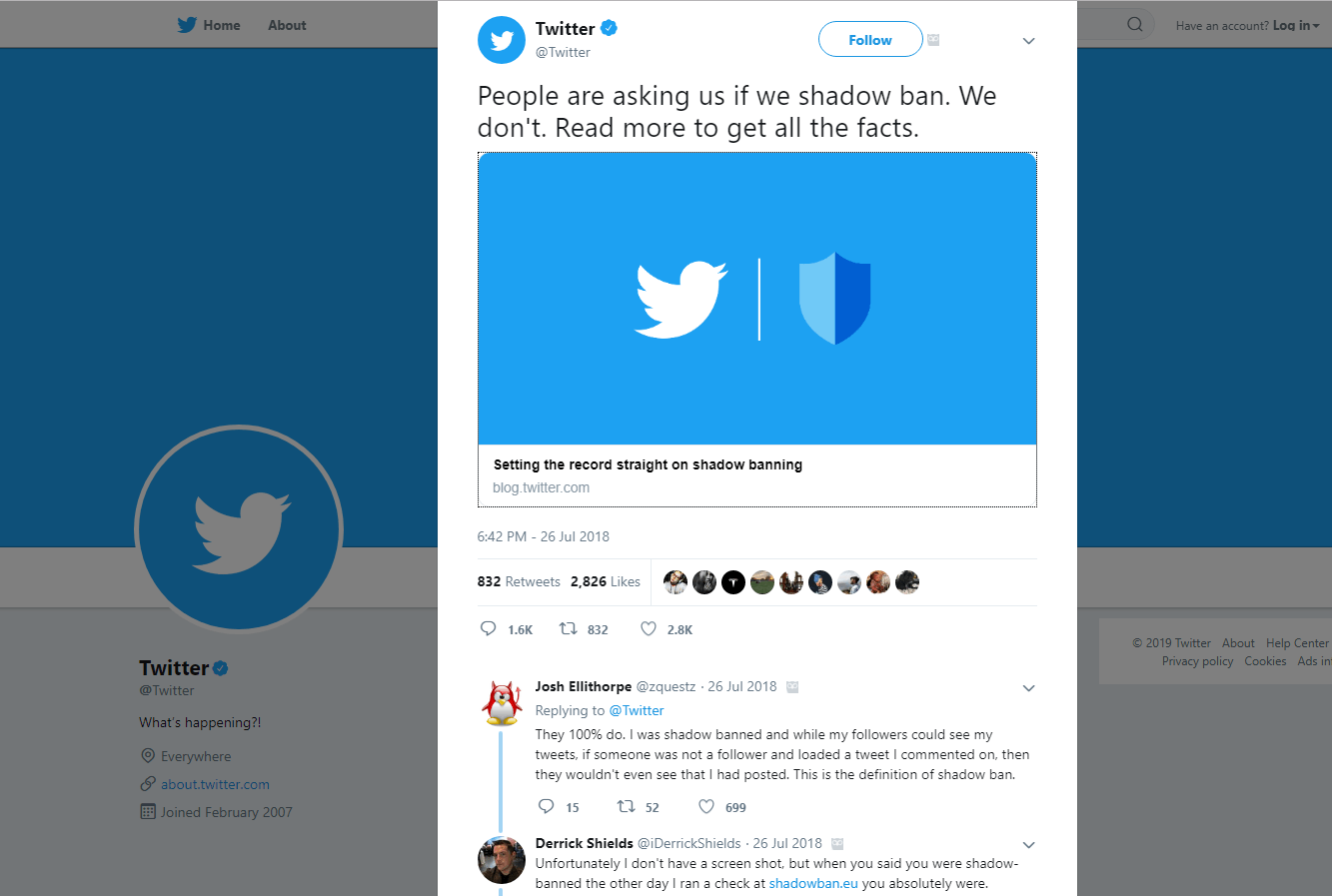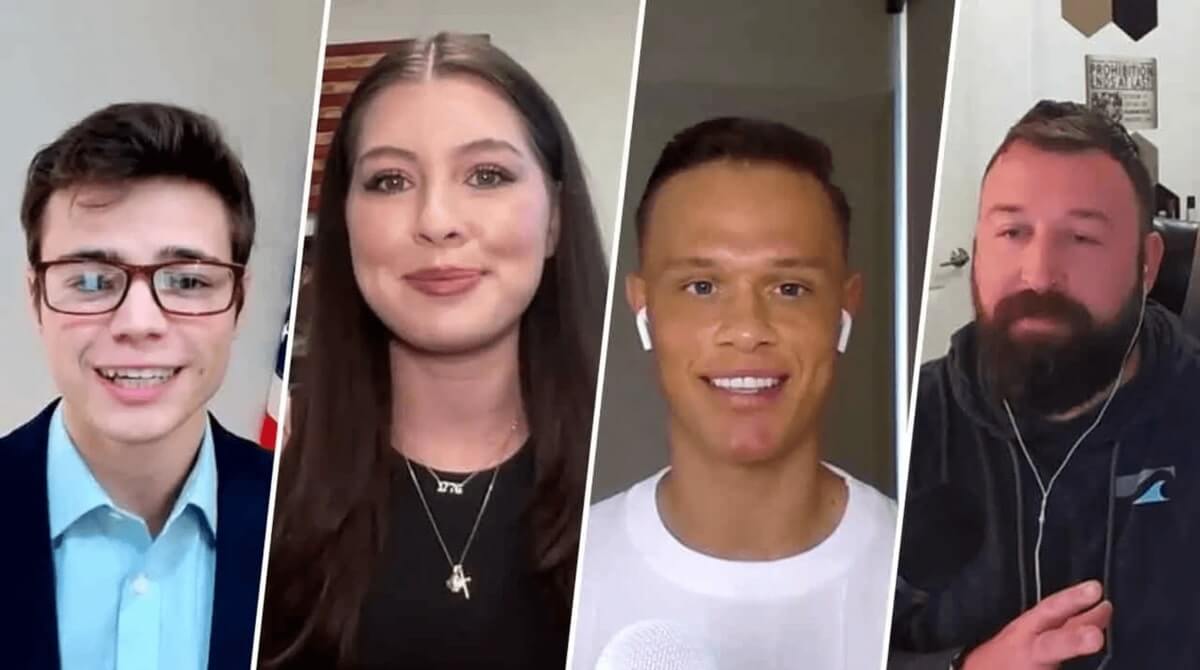What is a Shadow Ban?
Shadow banning refers to the practice of limiting or restricting a user's visibility on social media platforms without their knowledge.
Updated April 22, 2024.

Have you ever felt like your social media posts suddenly disappeared into thin air? It's like throwing a party and no one shows up! Well, you might be experiencing something called a 'shadowban'. Sounds spooky, right?
But don't worry, it's not as scary as it sounds. It is surprisingly straightforward to avoid if you follow the steps in this article.
Let's understand in detail about Shadow ban and how to avoid it.
What does getting shadow banned mean?
Shadow banning refers to the practice of limiting or restricting a user's visibility on social media platforms without their knowledge. Essentially, the user is unaware that their content is not reaching as many people as it should.
This can happen for various reasons, such as violating platform guidelines or being flagged by algorithms. The term "shadow ban" itself suggests that the user is unaware of the ban, as they can still post content, but it is not visible to others as it should be.
A brief history of shadow banning
According to The New York Times, the term "shadow ban" gained traction around 2012 when Reddit users accused the platform of banning a link to a Gawker article about transparency.
But the idea of shadowbanning goes way back. Imagine text-based chat rooms in the 1970s where players would play games like Dungeons and Dragons. If someone misbehaved, they'd get "toaded," which meant they'd be invisible to others.
Nowadays, shadowbanning is still a big deal. Politicians and famous people often claim that social media platforms are hiding their posts. Even Elon Musk, the guy behind SpaceX and Tesla, talked about it after buying Twitter (X). In 2022, he posted what seemed like proof of shadowbanning on Twitter, but then he got accused of it himself!
YouTube has also been in hot water over this. People said they couldn't find videos from PewDiePie, a famous YouTuber. YouTube denied it, though, blaming slow content checks because of Covid-19. The platform has also been accused of censoring conservative voices and people with opposing political viewpoints to the woke left.
How to know if you're shadow banned
First, keep an eye on your engagement. If you're seeing a sudden decrease in likes, comments, or shares on your posts, it could be a red flag that fewer people are seeing your content. Similarly, if your posts aren't popping up on public feeds or in hashtag searches, you might be missing out on potential engagement and new followers.
However, it's essential to approach these signs with caution. A drop in engagement doesn't always mean you're shadow banned. It could be due to changes in algorithms, seasonal fluctuations in follower activity, or simply that your content isn't resonating as strongly.
To be certain, you can check your Account Status on platforms like Instagram or keep an eye out for notifications from YouTube or Facebook.
Another helpful step is to conduct a profile audit. Review your recent activity, including comments and posts, and remove anything that might violate platform guidelines. This proactive approach can help ensure your content remains visible and engaging to your audience.
How to prevent being shadow banned
To prevent being shadow banned on social media platforms like Facebook, Instagram, TikTok, Twitter, and YouTube, it's essential to follow a proactive approach. Here's a comprehensive checklist:
- Understand platform guidelines: Familiarize yourself with each social platform's content, community, and copyright guidelines. Adhere to these guidelines strictly to avoid any violations that could lead to shadow banning.
- Stay informed about algorithms: Keep yourself updated on algorithm changes by reading guides available online, such as those covering Instagram, TikTok, YouTube, and Facebook algorithms. Understanding how these algorithms work can help you tailor your content effectively.
- Avoid "spammy" behavior: Refrain from engaging in behavior that may be perceived as spammy, such as repeatedly asking for likes, tags, comments, or shares. Let your content speak for itself, and focus on fostering genuine engagement with your audience.
- Use copyright-free content: When incorporating music or sounds into your content, ensure they are copyright-free. This helps to avoid copyright issues that could potentially lead to shadow banning.
- Maintain high-quality content: Ensure your content is of high quality, both visually and in terms of the topics covered. High-quality content is more likely to resonate with your audience and less likely to be penalized by algorithms.
- Adhere to terms of service: Regularly review the terms of service for each social platform to ensure compliance and avoid any potential violations. Avoid posting any inappropriate content, explicit content, adult material and the like.
- Diversify your content: Experiment with different types of content and themes to prevent algorithmic penalties for repetitive posting. For example, on Instagram, you could post reels, stories, videos, or carousel posts.
- Audit your hashtags: Regularly audit your hashtags to ensure they're relevant and not on any banned lists. Using banned hashtags can negatively impact your visibility and increase the likelihood of shadow banning.
Pro tip: looking to prevent shadow banning and grow your social media presence? Hire one of our vetted social media experts.
Which platforms use shadow banning?
Social media platforms have come under scrutiny for shadow banning, a practice where certain users or their content are restricted without their knowledge. While platforms like Facebook, Instagram, Twitter, YouTube, and TikTok deny shadow banning, they do have community guidelines that, if violated, could result in content demotion or removal.
Here's an overview of how shadow banning works on each platform:
Shadow banning on Instagram
While Instagram denies shadow banning, they downrank posts that are predicted to violate community guidelines. They also have recommendation guidelines to ensure offensive content doesn't appear in the Explore page or Reels feed.
Creating high-quality content that adheres to community standards and recommendation guidelines can help mitigate the risk of being shadow banned. You should also regularly monitor engagement metrics and seek clarification from Instagram support if visibility issues arise, which can aid in maintaining a positive presence on the platform.
Pro tip: Not seeing high enough engagement rates? work with one of our Best Instagram Experts to help scale your content.
How to Avoid Getting Shadowbanned on Instagram
- Adhere to community guidelines: Familiarize yourself with Instagram's Community Guidelines and ensure that your content complies with them to avoid any potential demotion or invisibility.
- Follow recommendation guidelines: Understand Instagram's Recommendation Guidelines to ensure your content is eligible for discovery on platforms like the Explore page and Reels feed.
- Regularly monitor account status: Use Instagram's Account Status section to monitor any content issues and address them promptly to maintain visibility.
- Avoid engagement baiting: Refrain from using tactics like asking for likes, tags, comments, or shares, as these can be flagged as spammy behavior and lead to content demotion.
- Use copyright-free music: Stick to using music and sounds available in Instagram's built-in libraries to avoid copyright issues that could potentially impact your content's visibility. The last thing you want to get is a copyright violation.
- Create high-quality content: Focus on producing high-quality photos and videos that resonate with your audience, as Instagram prioritizes engaging and relevant content. No explicit, violent, or harmful content.
Shadow banning on YouTube
YouTube doesn't shadowban channels but employs a strike system for violations of community and copyright guidelines. Three strikes can lead to channel removal.
YouTube has a unique approach to content moderation compared to other social media platforms. While they explicitly state that they don't shadowban channels, they do enforce strict Community Guidelines and Copyright Guidelines.
How to avoid getting shadowbanned on YouTube
- Understand community guidelines: Familiarize yourself with YouTube's Community Guidelines to ensure that your content adheres to their policies, avoiding any violations that could lead to demotion or removal.
- Respect copyright guidelines: Adhere to YouTube's Copyright Guidelines by using only content that you have the right to use, avoiding copyright strikes that could impact your channel's visibility.
- Monitor copyright strikes: Regularly check the Copyright section of YouTube Studio to stay informed about any copyright claims against your content and take appropriate actions to resolve them.
- Avoid Community Guidelines strikes: Be mindful of YouTube's Community Guidelines strikes, as repeated violations can result in your channel being removed. Take warnings seriously and adjust your content accordingly to prevent strikes.
- Produce original and engaging content: Focus on creating original and engaging content that resonates with your audience, as YouTube prioritizes videos that keep viewers engaged and coming back for more.
- Engage authentically with your audience: Foster a genuine connection with your audience by responding to comments, encouraging likes and shares organically, and building a community around your channel.
Are you being hit by the algorithm? Hire YouTube channel managers who can help you get your engagement stats up, help you find the right content creators to work with, and grow your channel.
Shadow banning on Facebook
Although Facebook denies shadow banning, they have content distribution guidelines that determine which content receives reduced distribution on the News Feed. Violations can result in demotion without explicit notification.
Facebook's content distribution guidelines play a significant role in determining the visibility of posts on users' News Feeds. Content that goes against these guidelines may be downranked, resulting in reduced visibility without clear communication to the creator. Violations of these guidelines can include issues such as spam, engagement baiting, misinformation, hate speech or content deemed low-quality.
Furthermore, the lack of transparency regarding shadow banning practices on Facebook has fueled skepticism and distrust among users. While the platform claims to prioritize user experience and content quality, the opacity surrounding the downranking of content raises questions about fairness and accountability.
How to avoid getting shadowbanned on Facebook
- Familiarize yourself with the guidelines: Take the time to thoroughly read and understand Facebook's community standards and content distribution guidelines. These content rules outline acceptable behavior and content on the platform, helping you steer clear of violations that could lead to shadow banning.
- Create high-quality content: Focus on producing high-quality content that adds value to your audience. Avoid sharing misleading information, spam, or low-quality content that could be flagged by Facebook's algorithms.
- Avoid engagement baiting: Do not ask for likes, shares, or comments in your posts. This is against Facebook's guidelines and can reduce your content's visibility.
- Stay up-to-date on policy changes: Keep yourself informed about any updates or changes to Facebook's policies and guidelines. Regularly check for announcements or resources provided by Facebook to ensure your content remains compliant.
- Monitor your reach and engagement: Keep an eye on your posts' reach and engagement levels. A sudden drop in reach or engagement could be a sign that your content has been downranked, indicating a potential shadow banning situation.
- Appeal content decisions: If you believe your content has been unfairly downranked or restricted, consider appealing Facebook's decision through the appropriate channels. Facebook provides options to appeal content removals or restrictions, allowing you to address any misunderstandings or mistakes.
Shadow banning on Twitter (X)
Twitter denies shadow banning but internal documents released by Elon Musk suggest otherwise. Twitter has been secretive about its practices, but Musk has promised transparency and is working on features to address concerns.
They have been under scrutiny for its handling of shadowbanning allegations. They've been making many content creators' content undiscoverable without notifying anyone. While they officially deny the practice, concerns persist among users. To ensure your account remains unaffected, consider the following:
How to avoid getting shadowbanned on Twitter
- Adhere to Twitter rules: Familiarize yourself with Twitter's community guidelines to avoid violating any rules. This includes refraining from engaging in abusive behavior, harassment, or posting sensitive content.
- Avoid spammy behavior: Twitter's algorithms penalize accounts that engage in spam-like activities, such as excessive tweeting, mass following/unfollowing, or using automated bots. Focus on organic engagement and avoid practices that may be flagged as spam.
- Quality content: Share relevant, high-quality content that resonates with your audience. Avoid posting repetitive or low-value content that may be deemed as spam by Twitter's algorithms.
- Engage authentically: Build genuine connections with your audience through meaningful interactions. Avoid artificially inflating your follower count or engagement metrics, as this may trigger Twitter's spam detection algorithms.
- Monitor account activity: Keep an eye on your account's performance and watch for any unusual fluctuations in engagement or visibility. If you suspect your account has been shadowbanned, reach out to Twitter's support team for assistance.
Want to avoid getting shadow banned on Twitter? Hire a top-notch social media manager that knows what they're doing.
Shadow banning on TikTok
While TikTok hasn't officially addressed shadow banning, they have community guidelines and may temporarily or permanently ban accounts for severe violations. They also regulate content to ensure it aligns with community standards.
TikTok's algorithm-driven platform can be a bit mysterious, and shadowbanning concerns have been raised by users. While TikTok hasn't officially acknowledged shadowbanning, here are some tips to minimize the risk:
How to Avoid Getting Shadowbanned on TikTok
- Follow TikTok's Community Guidelines: Familiarize yourself with TikTok's community guidelines and ensure your content complies with them. Avoid posting content that violates community standards, such as hate speech, harassment, or explicit content.
- Diversify your content: Create a variety of content that appeals to a broad audience. Avoid focusing solely on topics that may be flagged by TikTok's algorithms, such as sensitive or controversial subjects.
- Engage authentically: Build genuine connections with your audience by engaging in meaningful interactions. Avoid artificial methods to boost engagement, such as buying followers or likes, as these can raise red flags.
- Use relevant hashtags: Be strategic with your use of hashtags and ensure they are relevant to your content. Avoid using banned or inappropriate hashtags, as this can affect the visibility of your posts.
- Monitor performance: Keep an eye on your account's performance metrics, such as views, likes, and comments. If you notice a sudden drop in engagement or visibility, it could be a sign of shadowbanning. In such cases, review your content and ensure it complies with TikTok's guidelines.
Linkedin shadowbanning
Similar to other social media platforms, LinkedIn may employ algorithms and content moderation mechanisms to identify and suppress content that violates its community guidelines or terms of service.
LinkedIn users may find their content shadowbanned if it is deemed spammy, irrelevant, or in violation of LinkedIn's policies. Common reasons for shadowbanning on LinkedIn include excessive posting, using misleading tactics to gain engagement, or sharing explicit content that is flagged as inappropriate or low-quality by the platform's algorithms.
How to avoid getting shadowbanned on LinkedIn
- Adhere to LinkedIn Guidelines: Familiarize yourself with LinkedIn's content policies and guidelines to ensure that your posts comply with the platform's standards. Avoid posting spam, misleading content, or anything that violates LinkedIn's terms of service.
- Engage authentically: Focus on creating genuine interactions with your connections and followers. Engage with relevant content, participate in discussions, and provide valuable insights to establish yourself as a trusted member of the LinkedIn community.
- Share high-quality content: Prioritize quality over quantity when posting on LinkedIn. Share informative articles, industry insights, success stories, and thought leadership content that adds value to your network. Avoid overposting or sharing irrelevant content that may dilute your professional image.
- Build meaningful connections: Connect with professionals and organizations relevant to your industry or interests. Building a strong network of connections can increase the visibility of your posts and help you reach a wider audience on LinkedIn.
- Monitor your activity: Regularly review your LinkedIn profile and activity to ensure that your posts are resonating with your audience and aligning with LinkedIn's guidelines. Remove any content that may be deemed inappropriate or spammy to maintain a positive online presence.
Grow your accounts with the right experts
Shadowbanning is like the social media boogeyman – it's real enough to cause concern, but platforms don't always admit to it. While Facebook, Instagram, Twitter, YouTube, TikTok, and LinkedIn may not officially endorse shadowbanning, users often feel the effects when their content mysteriously loses visibility.
To steer clear of the shadowban, stick to the rules! Each platform has its own set of guidelines, so it's crucial to play by the book. Avoid spammy tactics, create engaging content, and be authentic in your interactions. By staying true to yourself and following the rules, you'll reduce the risk of falling victim to shadowbanning shenanigans.
Want someone legit to manage your social media profiles? Hire one of our vetted Mayple experts.
FAQs
What is an example of a shadow ban?
An example of a shadow ban is when a user's content is deliberately made less visible on social media platforms without their knowledge. This could mean their posts don't appear in search results, hashtags, or feeds, effectively limiting their reach and engagement.
How long does a shadow ban last?
The duration of a shadow ban can vary depending on the platform and the severity of the violation. In some cases, it may last for a few days to a couple of weeks, while in more serious cases, it could be longer or even permanent.
How do I get rid of a shadow ban?
To get rid of a shadow ban, it's essential to identify the reason behind it. Review the platform's community guidelines and ensure your content complies with them. Engage authentically with your audience, avoid spammy behavior, and appeal to the platform if you believe the shadow ban is unwarranted.
What is the difference between a ban and a shadow ban?
A ban is a direct action taken by a platform to restrict a user's access or presence, typically accompanied by a notification or explanation. In contrast, a shadow ban is more subtle, where a user's content is quietly limited in visibility without explicit notification, often leaving the user unaware of the restriction.







